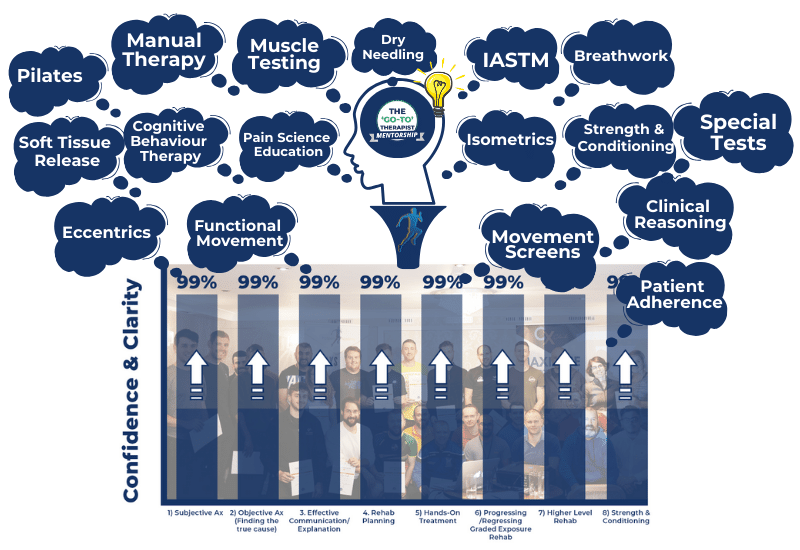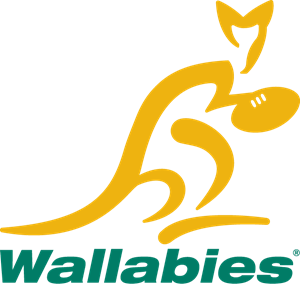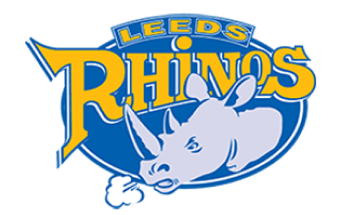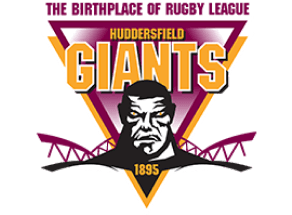
This System Is Trusted By...
The Harsh Realities And 3 Big Problems In Private Practice That Stop Clinics And Clinicians Growing To Their True Potential…
Have you ever finished an initial assessment and thought, "this one will be hard"?
You may find yourself stressing about how unclear their symptoms seem? You start to doubt yourself and as the sessions go on, your worries come true.
The techniques and exercises you usually use doesn't help. Your patient stops progressing and their adherence falls off a cliff.
It's tough to even get them to show up to the next appointment, not to mention give you a great review or tell their friends about you.
If this sounds like something you've gone through, don't stress - I had the same experience when I first started my own practice. Some weeks I had a full diary, but other weeks were empty.
The truth is, we need more time to get long-term results with complex patients. And this means we need specific skills in the first assessment so we can set the right expectations and give ourselves enough time to achieve these results.
The issue is that if you were anything like me, you were not taught these skills in university!
The Harsh Realities Of Private Practice…
- Private Practice Is High Pressure Environment
- Patients Expect Results Fast
- It’s Difficult To Know How Many Sessions It Will Take When Symptoms Are Not Like Textbook Cases
- Asking For Money At The End Of Sessions Can Be Awkward Especially When Patients Are Not Progressing
- You May Feel Pressured Into Performing More Manual Therapy That You’d Like
- It Can Be Difficult To Know If The Patient Is Safe To Go Back Doing Higher Level Activities Safely
The First Big Problem In Private Practice That Steals Therapist’s Confidence And Leads To Overwhelm!
After mentoring more than 1000+ therapists in over 40 countries all over the world, what I found is that many therapists focus on gathering technical skills like hands on and rehab techniques and (tactics) without any real strategy in place first.
They acquire more and more tactical information and knowledge early in their careers.
At a certain point, usually around 5 years into their career, many therapists get overwhelmed as you continue to accumulate more and more information without knowing how to apply it at the right time.
Knowledge is NOT power unless you can take that knowledge and APPLY it consistently and predictably!
In order to be able to think clearly and calmly in private practice, you must be able to organise all your knowledge and apply it at the right time.
This leads us to the second big problem in Private Practice that causes many therapists feeling high levels of stress on a daily basis…
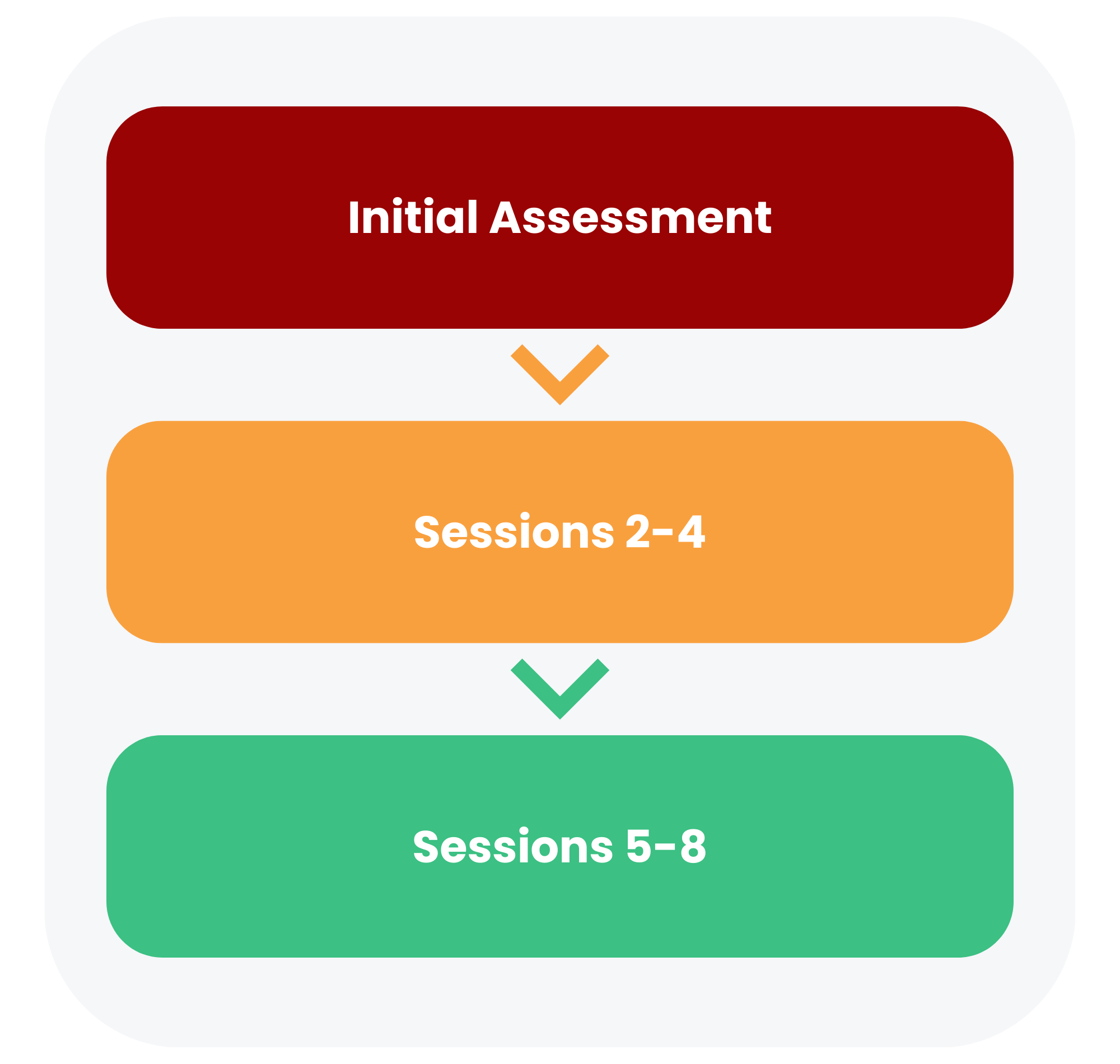
The Second Big Problem That Leads To Therapists Not Being Able To ‘Switch Off’ At Night And Patients Cancelling And Dropping Off
The second big problem in private practice is that there are different ‘skills’ required at different points of the patient journey which the majority of therapists do not have.
The reality is the majority of therapists have not have been exposed to these skills in university training or in the national healthcare system.
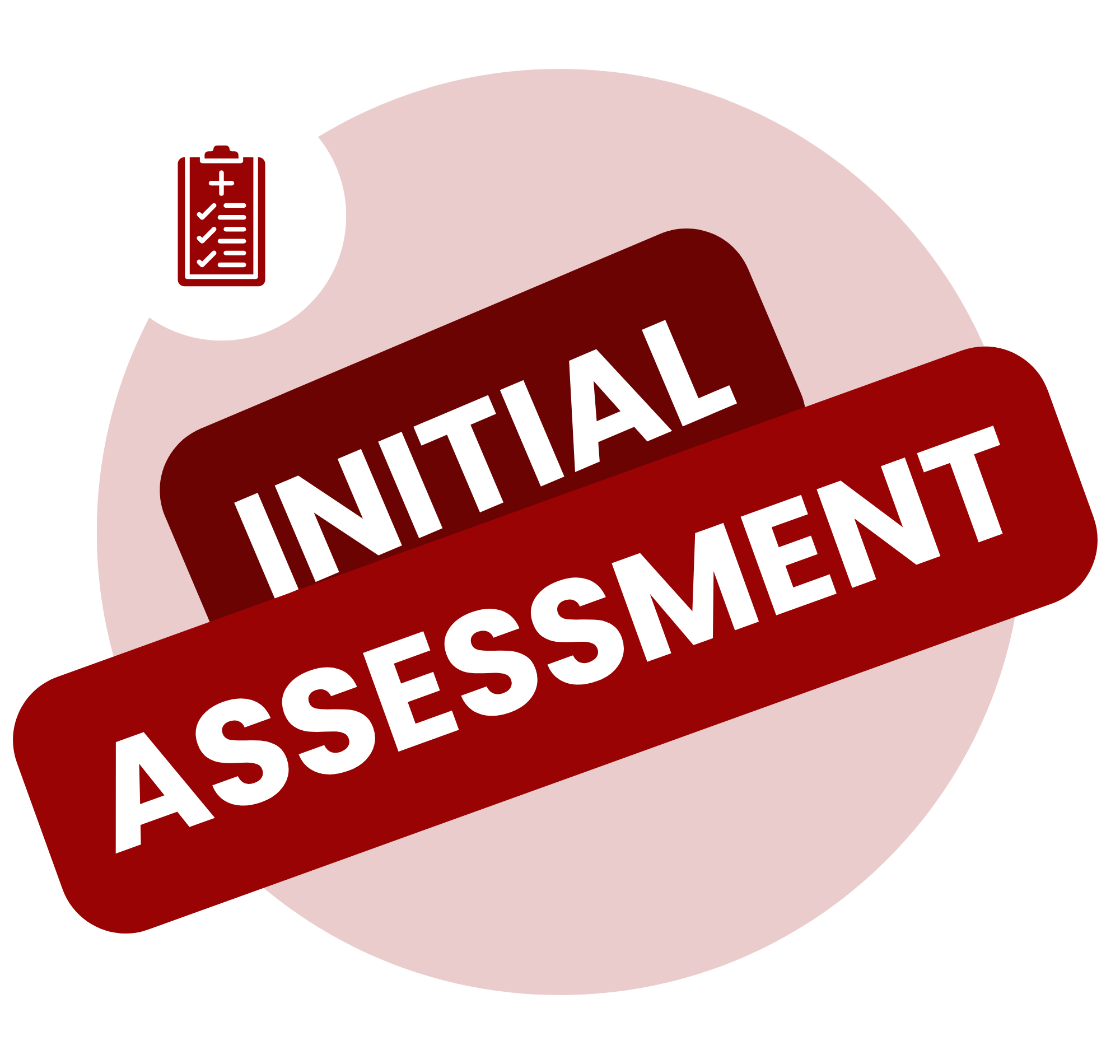
You Require Different Skills Through The Journey With Your Patient…
In the initial assessment we will need to be able to:
- Build Rapport & Authority
- Make Sense Of The Symptoms Quickly
- Answer The 4 ProSport Questions To Set Expectations
- Execute Effective Hands-On Treatment For Quick Pain Relief
- Design Meaningful Treatment Plans That Get Buy In & Adherence
- Prescribe Rehab That Gets Results And Keep Patients Feeling Progress
- Have Clear Next Steps For The Next Session!
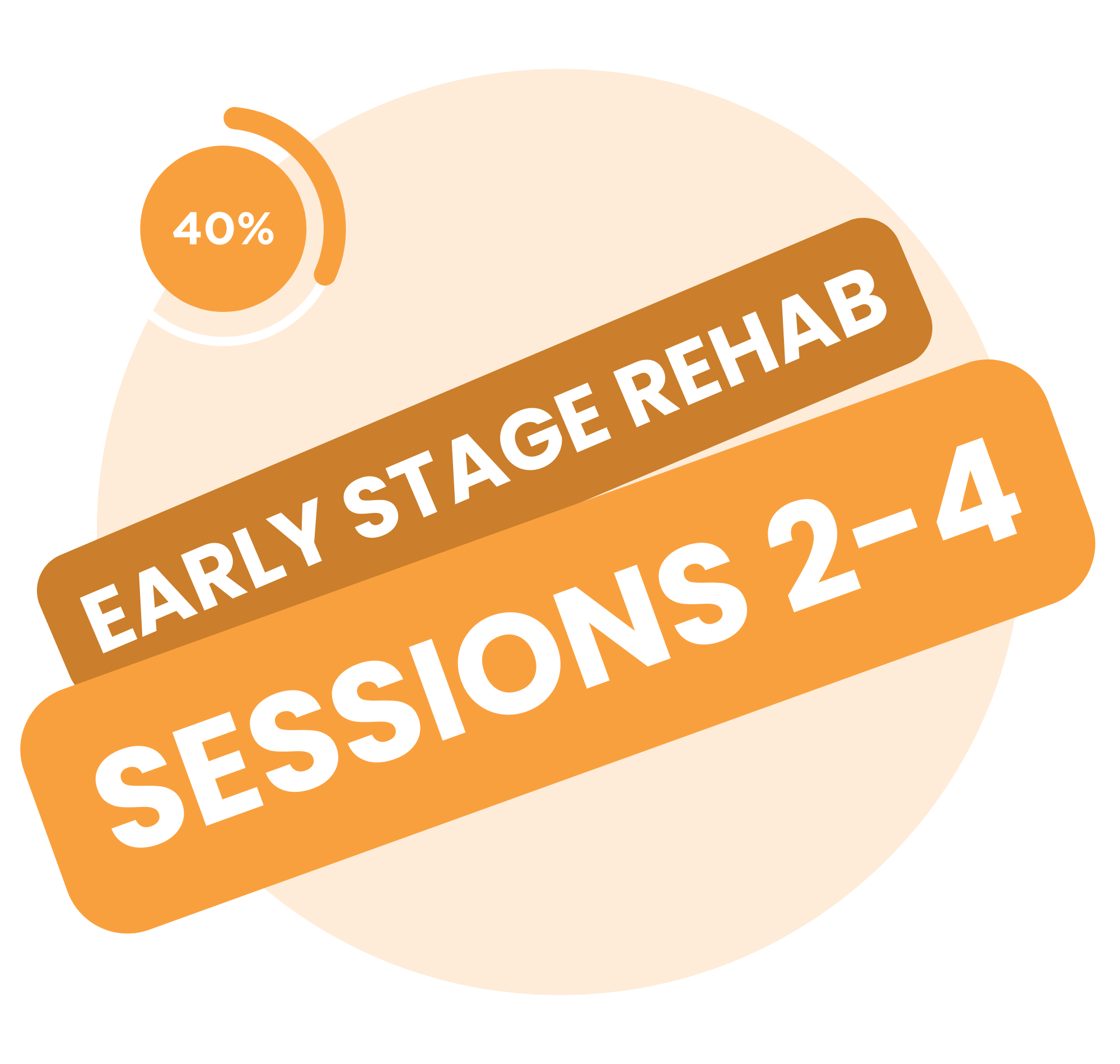
In The Early Stage Rehab We Need To
- Maintain Progress When Motivation Begins to Dip And Progress Slows
- Continue To Execute Effective Hands-On Treatment Without The Patient Becoming Over Reliant
- Prescribe The Right Rehab That Delivers Outcomes For The Patient On A Daily Basis
- Keep Patients Progressing Through Value Based Milestones
- Have Clear Next Steps Each Session
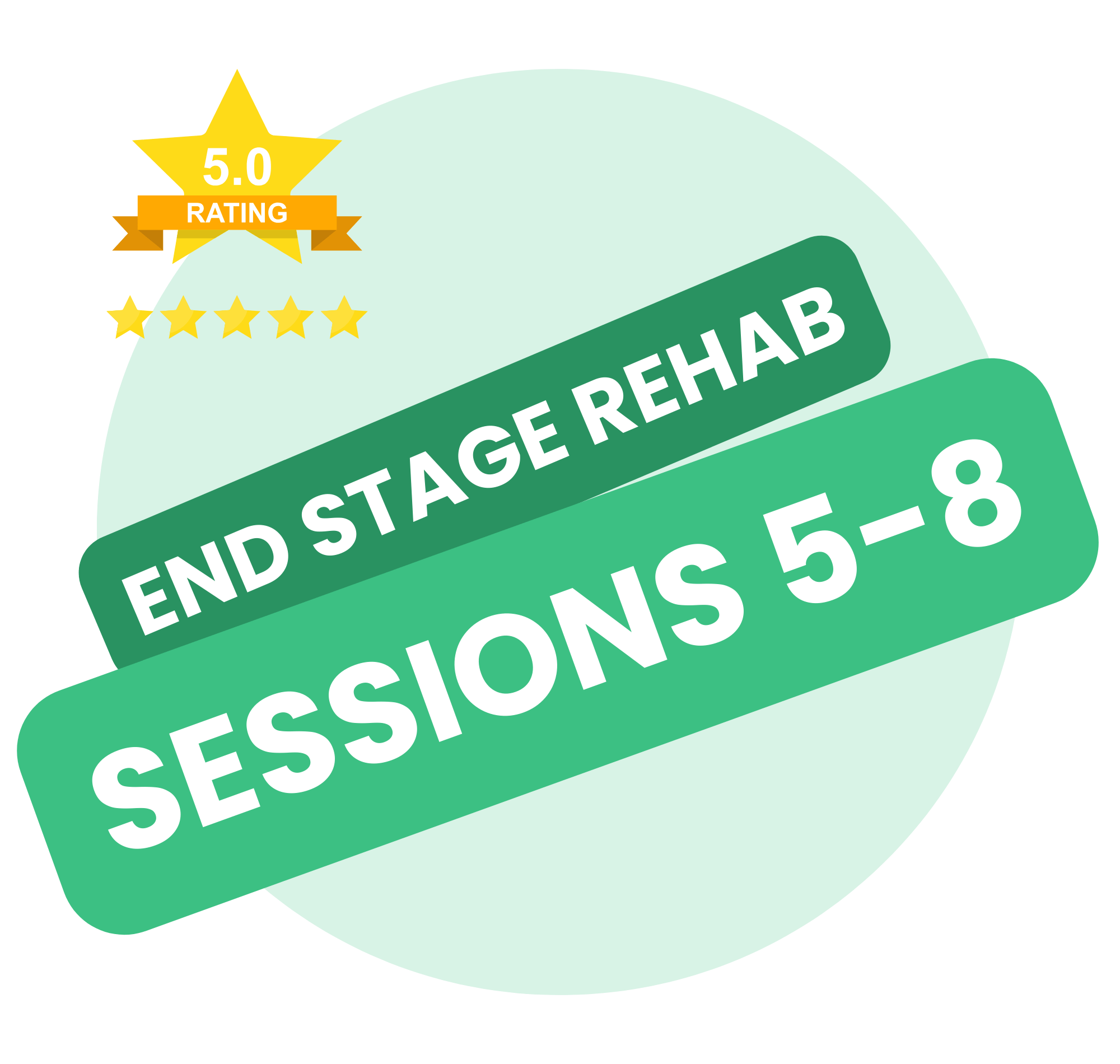
In The End Stage Rehab When The Pain Eases We Need To
- Maintain Progress And Commitment When The Pain Has Eased
- Bridge The Gap From Low To High Level Rehab
- Exceed Expectations In How The Patient Feels
- Keep Patients Progressing Through The Final Milestones Safely
- Turn These Patients Into Raving Fans That Earns Reviews, Referrals & Future Retention
As you can see, there are different skills required for different sessions and many of these skills are ‘non-clinical’ skills.
The Third Big Problem In Private Practice That Leads To Imposter Syndrome And Patient Progress Plateauing
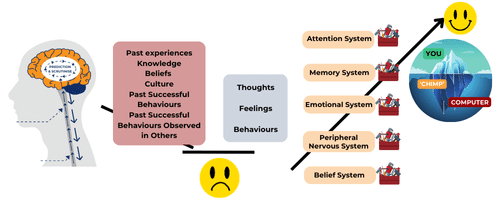
The third big problem in private practice is that pain is complex and multifactorial with the majority of patients not presenting like textbook cases.
The reality in private practice is that the majority of patients are presenting with ‘vague’ and ‘ambiguous symptoms’ and will have highly individualised drivers to their pain experience.
This means that although two patients may present with similar ‘symptoms’ very often they will react very differently to the same hands on treatment or rehab technique.
This is why it is critical to understand the ‘why’ behind everything you are doing.
The ‘Go-To’ Physio method has identified 5 key systems that need to be addressed with each patient in order to truly get them back to moving with ‘thoughtless, fearless, movement’ (Gifford, 2013).
Each patient will need varying degrees of focus on each system specific to their story.
The 5 key systems that need to be addressed with every patient are:
- The Belief System
- The Memory System
- The Attention System
- The Peripheral Nervous System
- The Emotional System
Therefore the private practice therapist needs frameworks and ‘tools’ for each system to truly help any patient who walks through your door.
For a ‘standard’ anterior knee pain patient, you might be predominantly focusing on the peripheral nervous system with tools such as hands on treatment and rehabilitation exercises.
Yet for a persistent pain patient you may need to have tools to address all 5 of the key systems that are important to helping a patient move with ‘thoughtless, fearless, movement’.
Tools may include pain science education, breathwork, visualisation, cognitive behaviour therapy etc.
The tools are not the most important thing. It is the ability to use the right tool at the right time that is critical to being able to keep your patient progressing in each session.
So What’s The Solution To These Three Big Problems?
The art of private practice physiotherapy really comes down to having the right knowledge, skills and tools to be able to implement at the right time with the right patient.
And after years of trial and error and having professional sports stars retire on my watch, I realised that what I really needed was a step by step system to help me organise my knowledge. This in turn empowered me to be able to confidently ‘troubleshoot’ any patient who comes through the door.
And that is what I set out to do and finally committed to building a step by step system to help me critically think and find the root cause specific to the person in front of me.
Introducing The ‘Go-To’ Physio Method…
A System; A set of interconnected or interdependent components or elements that work together to achieve a common goal or purpose.
Once I mapped out the patient journey and identified the knowledge, skills and tools required to be successful in private practice, I was able to break these down into 8 key pillars.
Within each pillar contains a series of frameworks that will help you focus and ‘troubleshoot’ any patient at any point of the journey.
That is the true power of having a step by step system in place. You know exactly where you are at all times and are able to progress or regress accordingly.
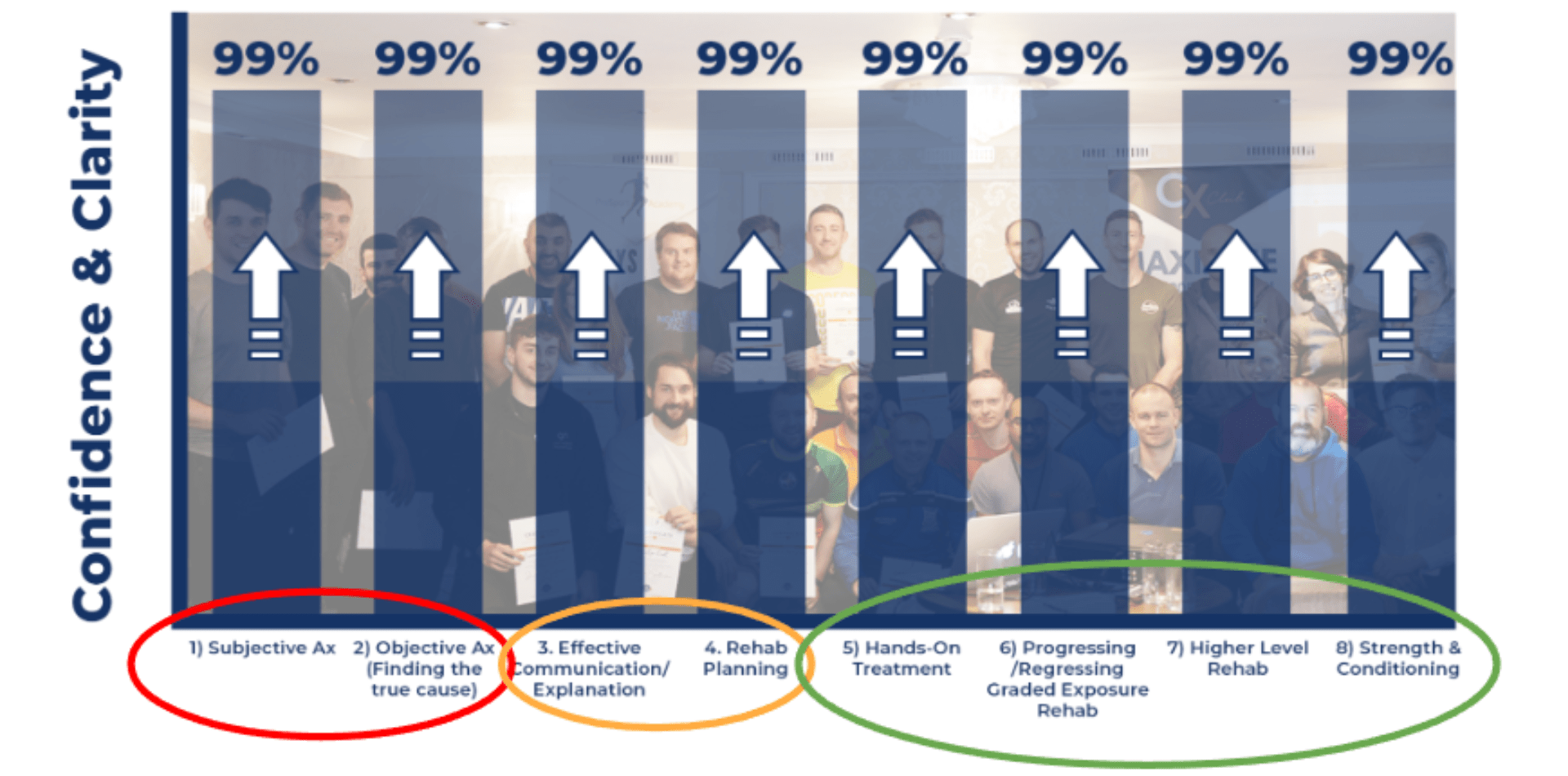
Here Are Some Of The Key Benefits I Immediately Noticed From Having A Step By Step System In My Clinical Practice:
- Allows you take ALL YOUR KNOWLEDGE and easily organise it so you can APPLY it at the right time
- Avoids Overwhelm as you now have a framework for each step of the patient journey
- Super focused in sessions as you now are just getting your patient to the next step rather than trying to do everything in one session
- Saves you time because of new levels of focus
- Easily able to progress or regress as you know exactly where you are with your patient
- If your patient gets stuck or plateaus, you revert back to the relevant framework to critically think and ‘troubleshoot’ you to the next step
- Improves your consistency of results
- Less energy drain and less decision making (decision fatigue)
- Finally able to switch off at night with more energy for your family
Other Benefits I Noticed From Having A Step By Step System As My Practice Grew
- A standard of care across the practice
- Protects the reputation of the practice
- Delegation becomes easy to other therapists
- Onboarding therapists becomes easier
- Easier to grow the clinic while protecting the reputation you’ve worked so hard to build
- Can leave the clinic for months at a time to work at World Cups with peace of mind
The 8 ‘Go-To’ Physio Pillars To Confidently Helping Any Patient Who Walks Through Your Door
Each of the 8 pillars contain a series of principles, strategies and frameworks that then empower you to APPLY your ‘tactical’ techniques with clarity and confidence in every single session.
As you work through each pillar below, consider what courses and knowledge you’ve acquired and which pillar they would sit in.
Once complete, you can then easily identify any ‘gaps’ in knowledge, skills or tools that you need to fill in order to confidently help any complex patient who walks through your door.
With that said, let's examine each pillar in more detail:
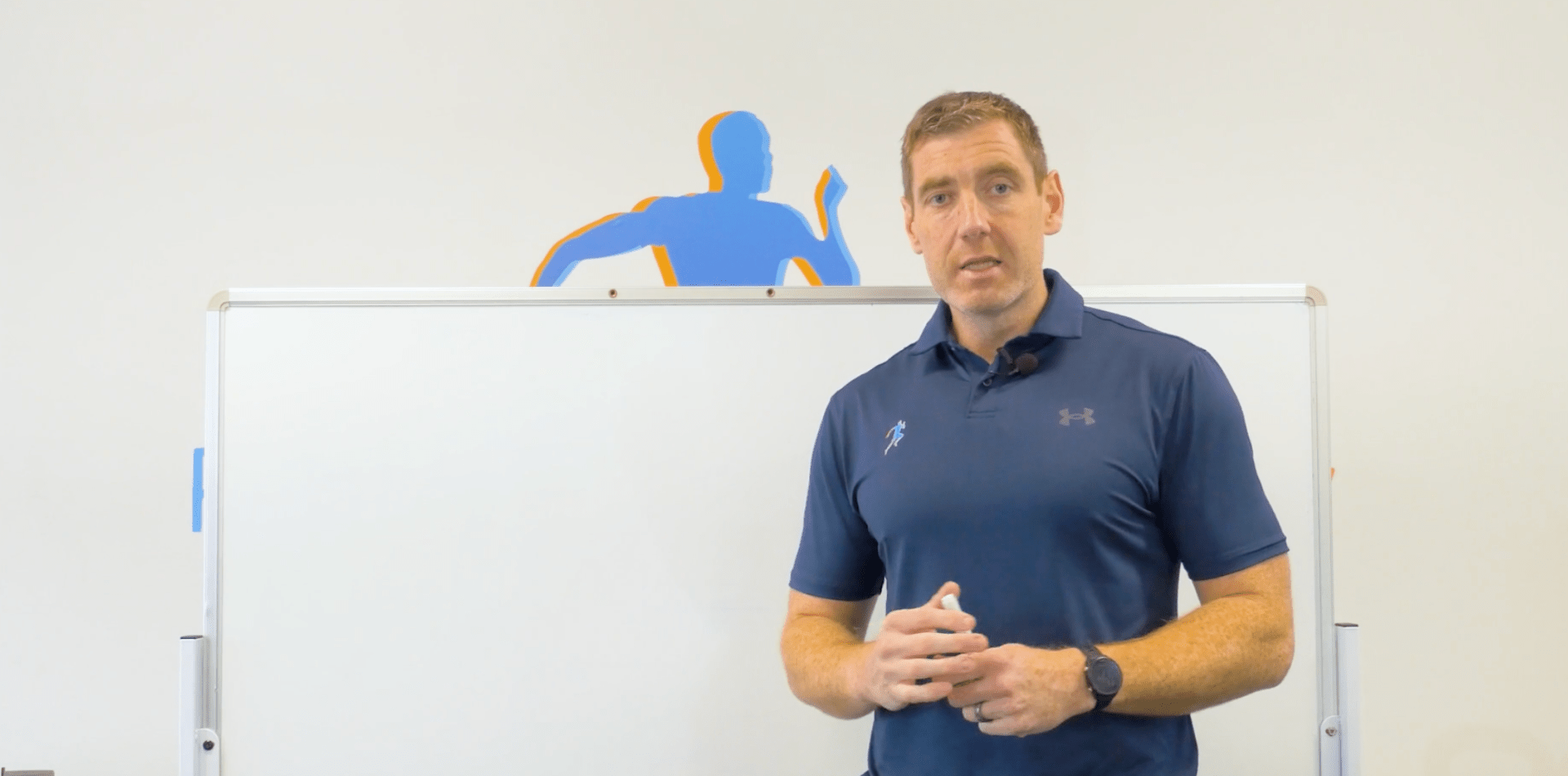
Therefore, asking the right higher quality questions that get higher quality information from your patient is critical.
This allows you to make sense of your patient's symptoms and identify the peripheral tissues that are contributing to the pain experience during aggravating and easing movements.
An understanding of modern pain science can be extremely helpful in this pillar to help make sense of those vague ‘aches and pains’.
In the ‘Go-To’ Physio method, the treatment plan is designed by the patient in the subjective assessment (unbeknown to them).
This ensures a patient-centred approach and helps the patient feel empowered and motivated to adhere to the plan in the coming sessions.
There are some other critical tasks covered in the subjective assessment that helps the therapist overcome hidden objections from the patient that could derail the success in further sessions.
The key point here with the subjective assessment pillar is:
“Knowledge is having the right answers. Intelligence is asking the right questions.”
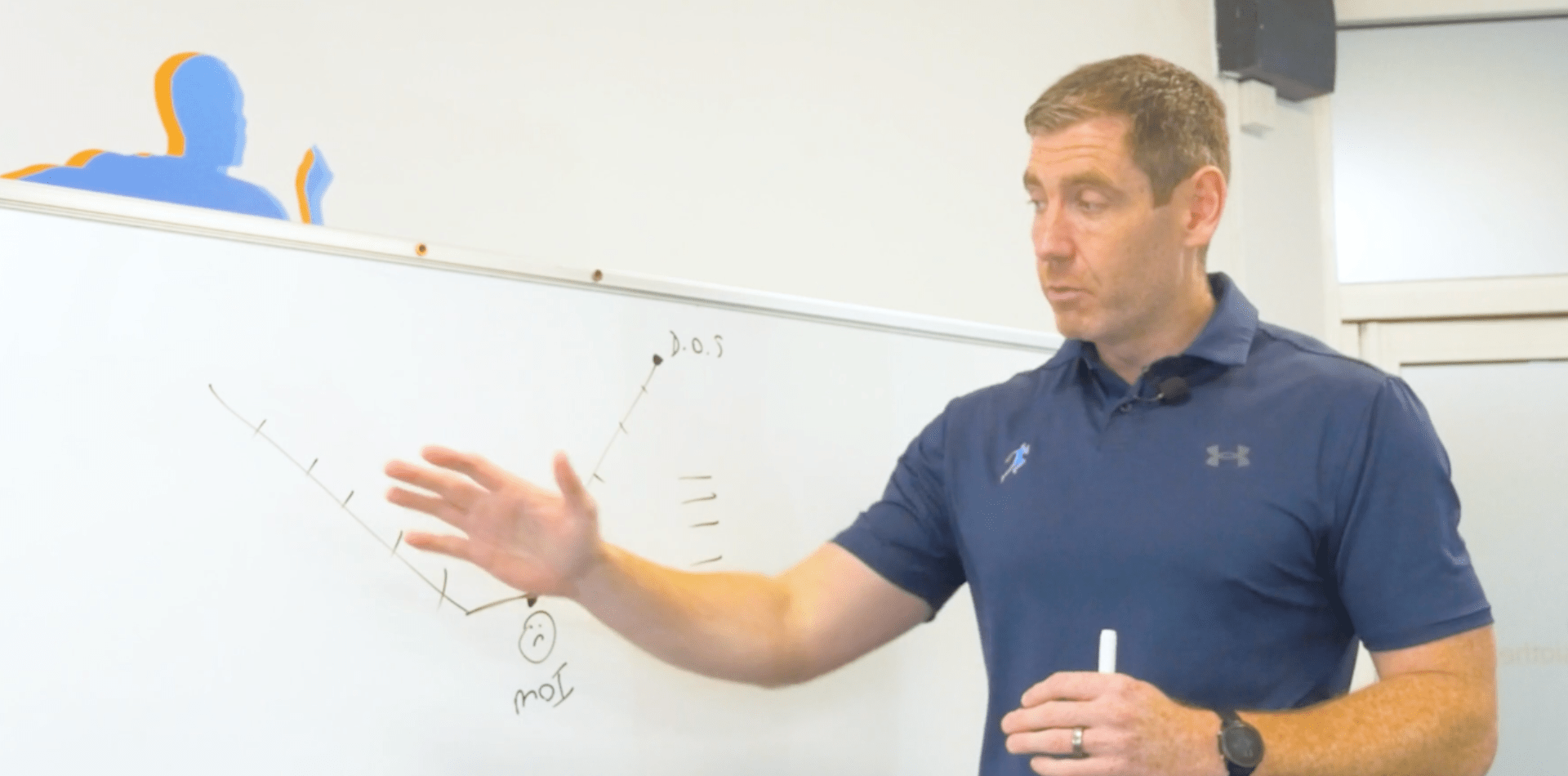
Next we move to the objective assessment.
The ‘Go-To’ Physio Method moves away from a ‘diagnosis’ based assessment and towards a ‘shopping basket’ approach.
First termed by Louis Gifford, a shopping basket approach empowers the therapist to easily identify ‘maladaptive’ movement strategies that may still be lingering that are stopping the patient in everyday life.
This empowers you to focus on things you can influence in the objective assessment rather than missing the ‘wood from the trees’ with a strictly ‘diagnosis’ based approach.
A key critical thinking question used in the ‘Go-To’ Physio Method objective assessment is;
“What is not doing its job, that if it was doing its job, this pain/problem would no longer exist?”
This allows you to focus on finding the root problem and ensure the treatment plan solves it once and for all. This simplifies the objective assessment and empowers you to act more effectively with your tactical techniques.
Other key physiological and neurological principles are at play in the ‘Go-To’ Physio Method objective assessment frameworks which includes how human movement occurs in the real world.
This includes the behaviour of muscles and passive tissues to manage perturbations, force steadiness and motor adaptations to pain and/or stress.
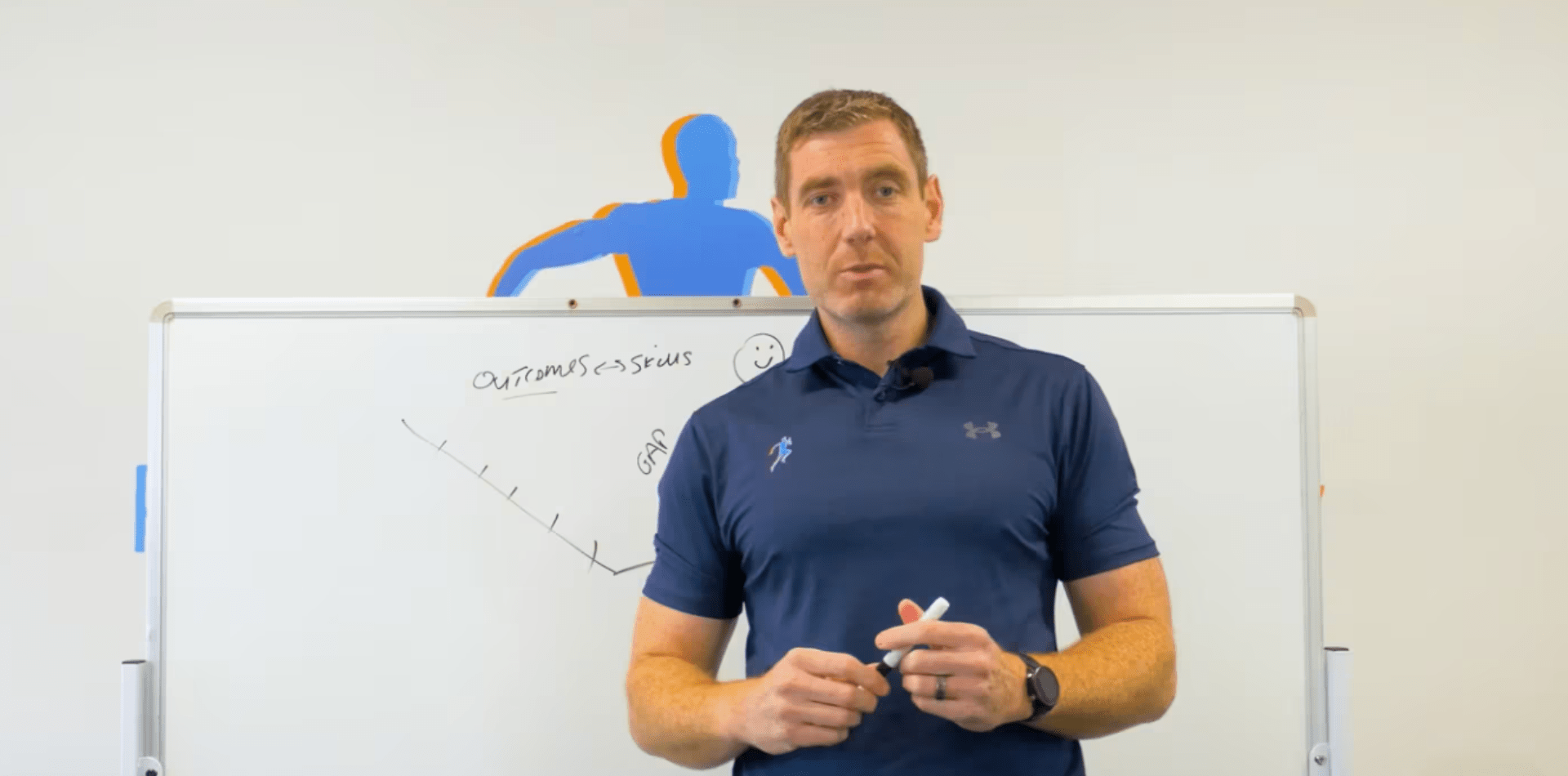
Effective communication skills are non-negotiable as a ‘Go-To’ Physio.
Why?
Because this is the start of the treatment process! Louis Gifford said it best;
“Reassurance is a pain killer!”
There is a big therapeutic effect during this process that has the opportunity to update the patient’s belief systems. Therefore this pillar is not only about setting expectations and getting patient ‘buy-in’.
The ‘Go-To’ Physio Method gives you a framework to consistently explain the problem, solution, and plan to a patient.
Unlike most pain science explanations, instead of trying to pull the patient up to our level with fancy words and scientific terms, we need to go down to the patient's level and explain the problem, solution and plan in simple terms that the patient can understand.
The ‘Go-To’ Physio method has simple frameworks in this pillar for executing this skill.
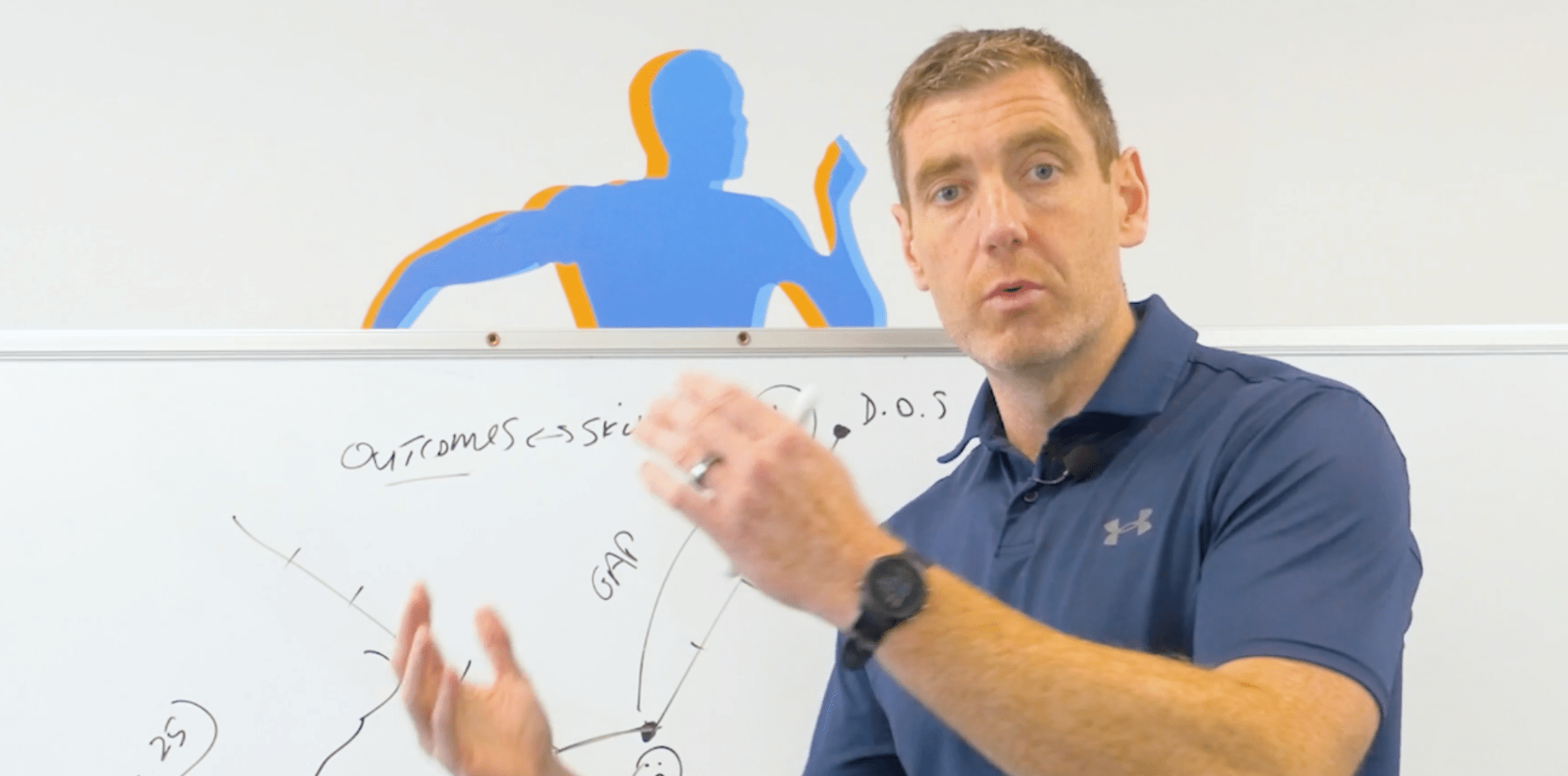
With your effective explanation skills sharp from pillar three, you can now take the high quality information from the subjective assessment and organise it in a way that designs a meaningful treatment plan for the patient.
Another key therapeutic benefit to mapping out the treatment plan and giving a realistic estimate of how many sessions it will take is;
“A patient trusts a therapist with a plan far more than a therapist just ‘winging it’ session by session.”
The treatment plan includes key milestones along the journey that allows the patient to see they are on the right track. These milestones are critical for patient adherence in later sessions.
Another key framework for the ‘Go-To’ Physio in this pillar is to design the treatment plan based on the outcomes the patient wants and needs first and foremost.
From here you can then break down the key skills and exercises required for the patient to achieve these outcomes. This ensures you are always designing a bespoke ‘value based’ treatment plan for every patient.
It ensures you avoid trying to fit every patient into a set of exercises but rather look at the person first, pain second. This allows you as a ‘Go-To’ Physio to truly deliver a patient-centred treatment plan.
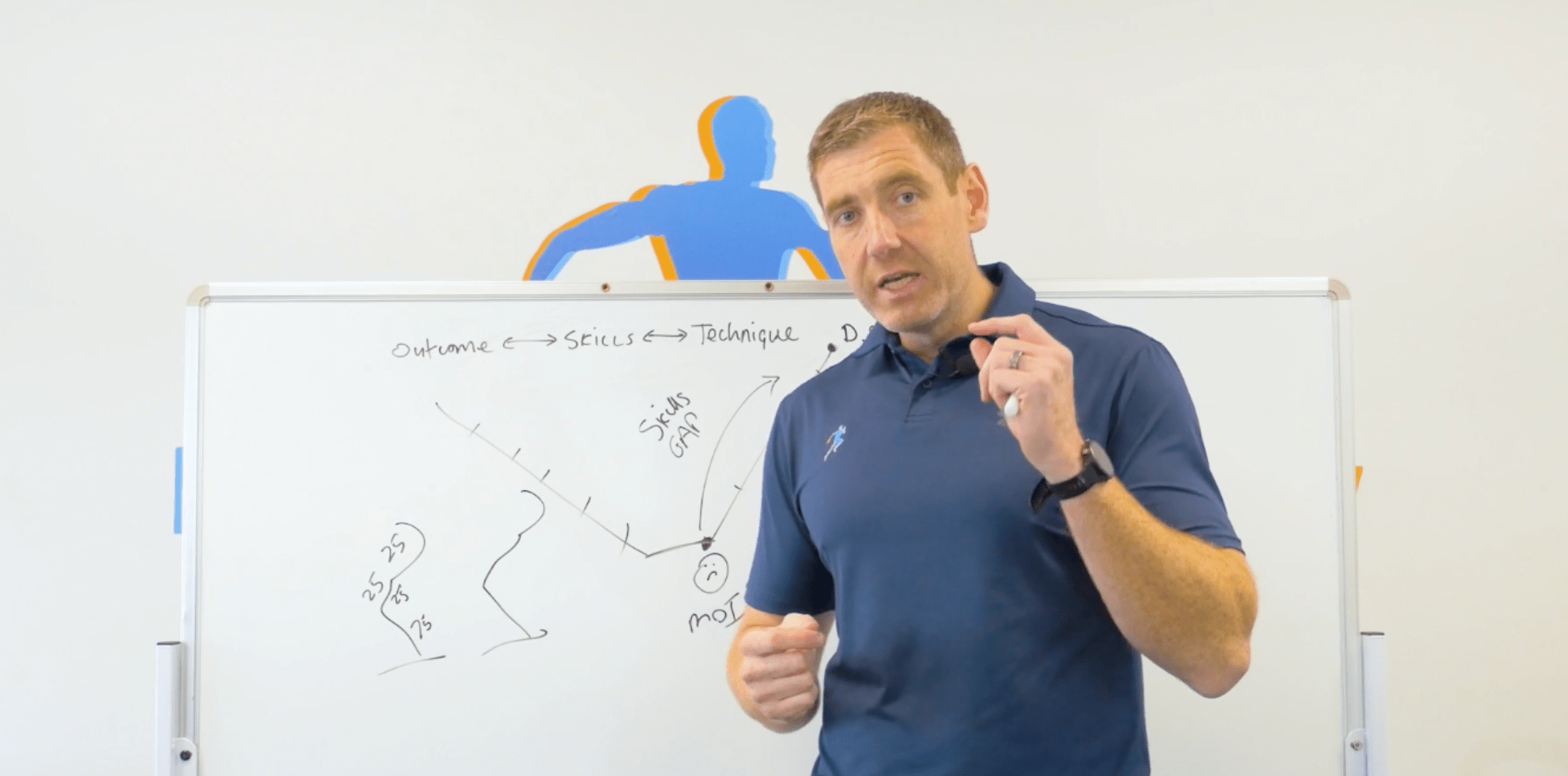
The 'Go-To' Physio Soft Tissue Release approach (GSTR) is a targeted set of manual therapy techniques designed to identify and address maladaptive movement strategies that may be contributing to your patient’s pain experience. Developed as a piece of the full 'Go-To' Physio Methodology, GSTR aims to work with your patient’s nervous system to restore the ability to tolerate load and redevelop the skills required to achieve the functional outcomes desired.
At the heart of the ‘Go-To’ Soft Tissue Release technique is sound clinical reasoning and clear key performance indicators. This ensures that therapists ‘understand the why’ behind everything they are doing and can easily course correct if they are not on the right track.
This will save your hands but also ensure you do not unnecessarily ‘flare patients up’ or allow them to become ‘reliant’ on hands on treatment.
This pillar also leans on key mental models (such as second order consequences), critical thinking skills, manual muscle testing and other key frameworks from the ‘Go-To’ Physio Method to apply the right technique at the right time.
The 'Go-To' Soft Tissue Release Technique is more than just a set of manual therapy techniques; it is a comprehensive approach to looking at the person first, pain second and addressing the underlying causes of musculoskeletal dysfunction.
By focusing on the patient’s story, undoing maladaptive movement strategies (using second order thinking principles), improving range of motion, and enhancing load tolerance, GSTR plays a pivotal role in helping the patient ‘feel’ the difference in the first and subsequent sessions.
“Clinical Reasoning + Nervous System Based Hands On Approach = The ‘Go-To’ Soft Tissue Release Technique”
As part of the ‘Go-To’ Physio Method hands on treatment protocol, the hands on techniques are immediately followed by low level rehab to further reassure the nervous system it is safe to tolerate load.
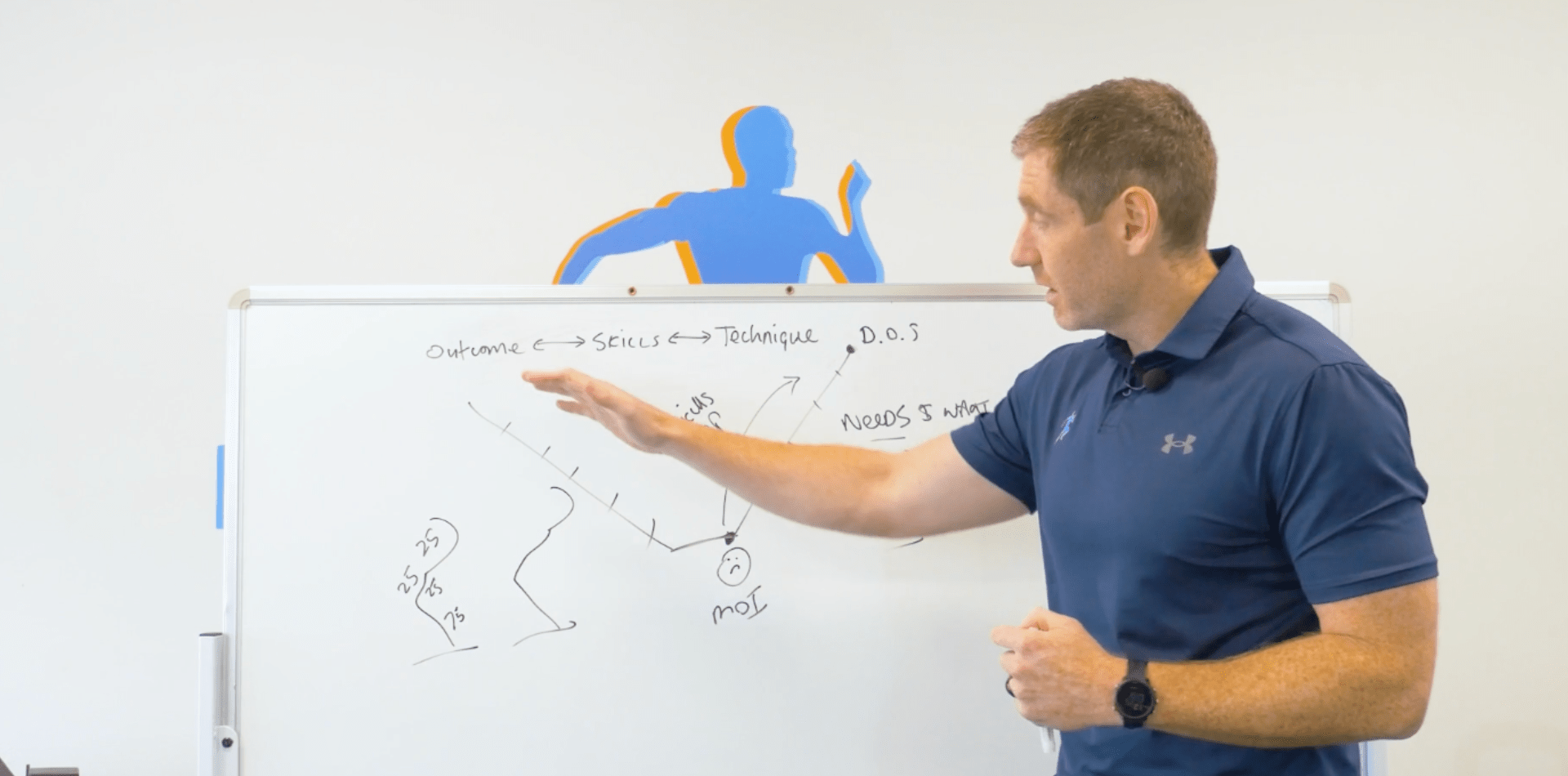
One of the key ‘Go-To’ Physio principles of the early stage rehabilitation exercises is to put the tissues that are not doing enough work in a position where they've got no choice but to tolerate load.
The early stage rehab exercises ensure that all levels of the nervous system’s ‘threat detectors’ are engaged in the process in order to truly ‘reassure’ all levels that it is safe to tolerate load again.
This pillar is here where you will also use the information gained from the objective assessment to take away the ‘maladaptive’ strategies that the patient’s nervous system will usually try to use as per the motor adaptation literature.
Another key principle at this level is to ensure the ‘attention system’ and subconscious mind is fully engaged in the exercise. The ‘Go-To’ Physio can achieve this using a number of physiological and neurological principles in your rehab approach.
This in turn can decrease the perceived threat, increase range of motion quickly and bring about more long lasting ‘processing changes’ which is advantageous for the high pressure environment of private practice.
“If your patient can ‘feel the difference’ of your rehab exercises, then becoming reliant on hands-on treatment will never be a problem again!”
The patient will feel the difference immediately and will not become reliant on hands on treatment as these exercises will give the patient the exact same ‘feeling’ that hands on treatment gives them.
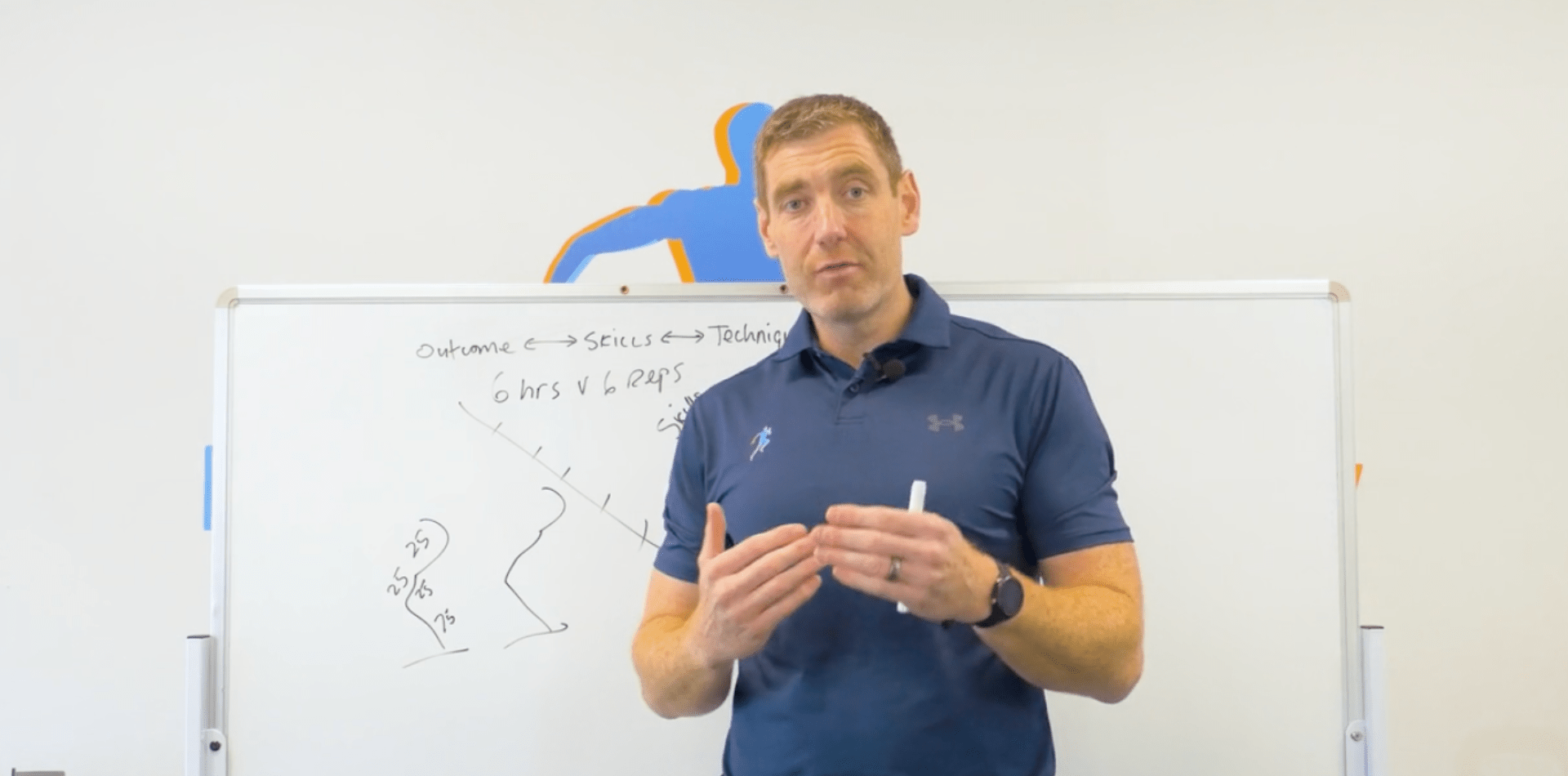
As the pain/discomfort begins to ease the ‘Go-To’ Physio changes strategy on the quest to help your patient move with ‘thoughtless, fearless, movement’. A key strategic shift at this level of the graded exposure ladder is putting the tissues that were not doing enough work now into situations where they have to work well with tissues that were doing ‘too much’ work.
This gives the nervous system an opportunity to self organise and allow the synergists and antagonists to cooperate and work interdependently as per real life situations without higher centre involvement.
Another key strategic shift is moving towards more dynamic and faster movements that are more concerned with lengthening changes in the peripheral tissues and rate of change of length. This ensures that if the patient needs to move in a certain direction quickly, the nervous system does not ‘overreact’ with a protective strategy. The exercises at this level will allow the patient exposure to do their everyday tasks with optimal energy efficiency.
Remember…
“A world class patient experience is a ‘feeling’. They must FEEL the difference you are making and this feeling must far exceed the price!”
The work must come before the belief. Your patient must be exposed to situations that are stressful for their nervous system to give them an opportunity to earn back the confidence and self belief in their bodies.
This is where the magic happens and the value is delivered to the patient where the work has to happen before the confidence emerges.
It is at this level where the patient further updates their belief system and they do things again where they never thought was possible.
Raving fans are created at this leve when true value is delivered that far exceeds the price paid for your services.
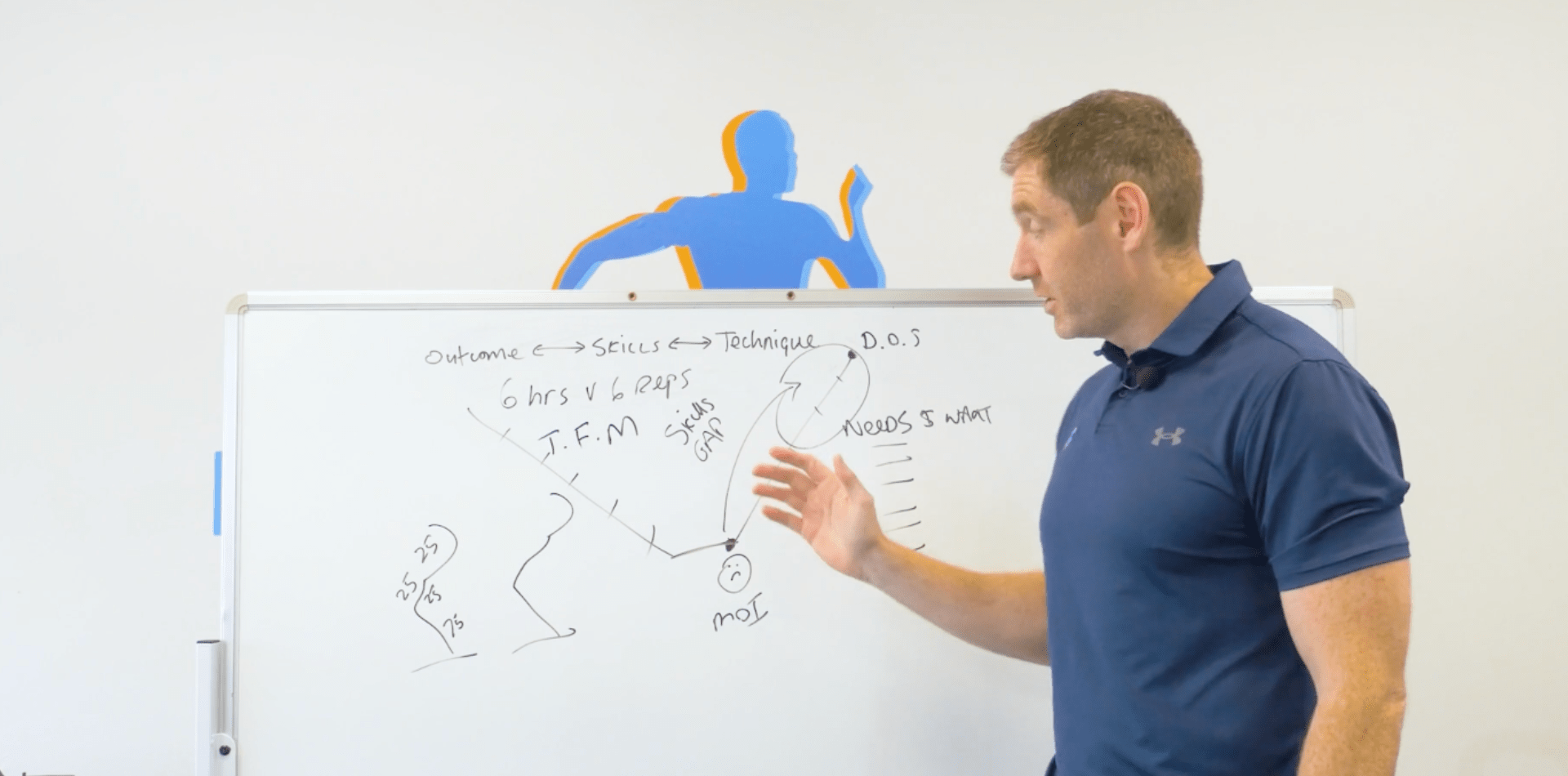
The final pillar of the ‘Go-To’ Physio Method is Robustness and Resilience. This phase may look different for different patients.
For example an ‘weekend warrior’ or sporting patient may need to build robustness and resilience by managing external loads in the gym.
A field based athlete may need further exposure to acceleration, deceleration and running progressions at this level. This is where the ‘Go-To’ Physio has the skills to train the deceleration, acceleration and top end speed capabilities of the patient in three dimensions.
The ‘Go-To’ Physio must create situations in a graded exposure manner in which we show the patient’s nervous system it is safe to tolerate loading at the highest speeds of movement if applicable.
Remember…
“It is critical to expose the patient to the loads they are required to tolerate in the real world. ”
For a non-sporting persistent patient, this phase may look very different to the active sporting patient. This patient may require graded exposure to certain stressful environments and situations whereby they can go into ‘fight or flight’ but then return back to ‘rest and digest’ at the appropriate times. The patient must have the tools to feel empowered to not only survive but thrive in everyday life situations.
The Complete Clinical System For Rapid Practice Growth Without Compromising Quality Patient Care
The ‘Go-To’ Physio Method was built in professional sport and refined for my own private practice over the past 15 years. It is responsible for helping over 1000+ therapists in over 40 countries all over the world finally have the confidence to help any patient who walks through their door ethically progress all the way to the final session.
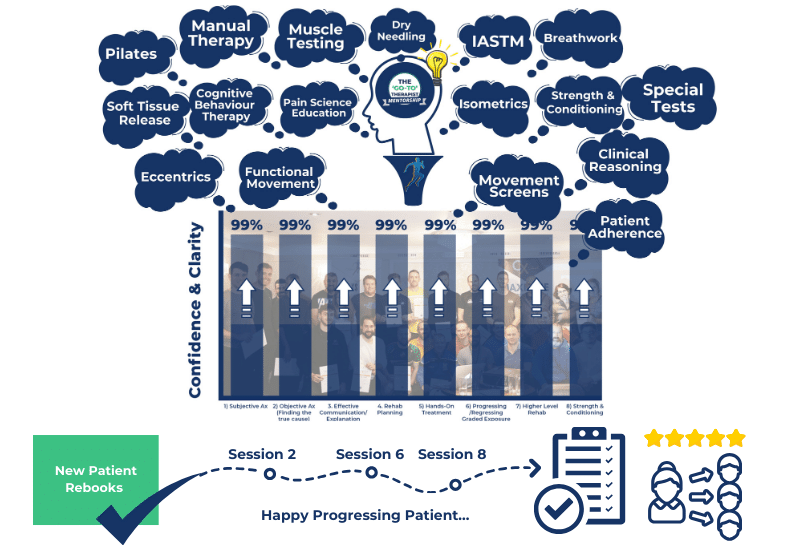
It contains a complete structured step by step system that gives you the skills and techniques required to not only survive in private practice but thrive!
It incorporates modern pain science education, breathwork, hands on treatment and other key rehabilitation ‘tools’ to empower you to use the ‘right tool’ at the ‘right time’ for those ‘vague’ symptoms that we so often see in private practice.
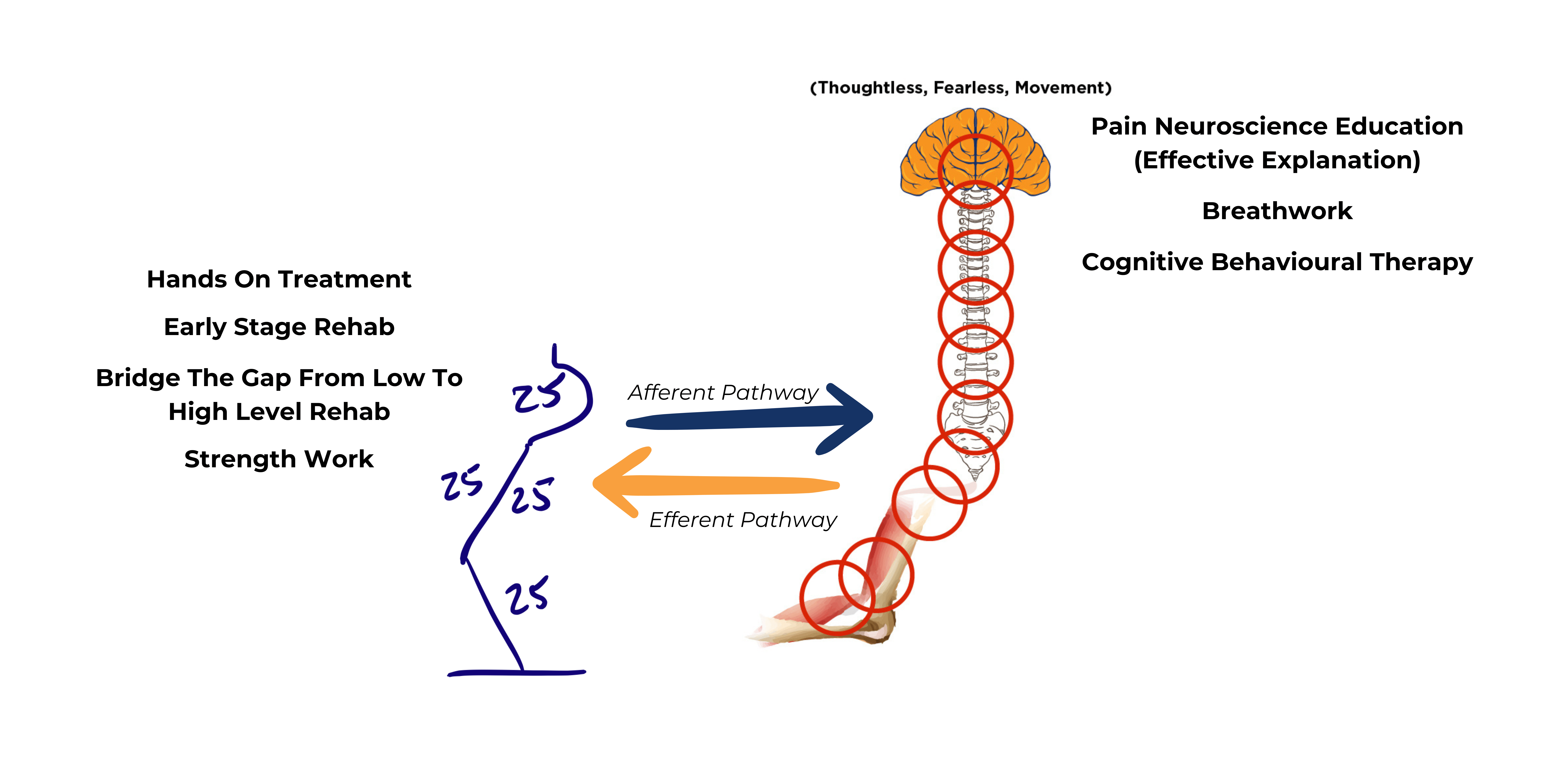
The ‘Go-To’ Method Clinical System Contains 7 Core Modules That Helps You Organise All Your Knowledge Into A Step-By-Step System That Gives You A Competitive Edge For Solving Complex Cases

Module 1 helps you organise your subjective assessment to ask the right questions that allows you to find the root cause of the problem while empowering the patient to design their treatment plan ‘outcomes’ in a way that is meaningful and ‘valuable’ to them.
Module 2 helps you make sense of the patient's symptoms and organise your objective assessment that helps you ‘think clearly’ and easily identify the ‘gaps’ stopping the patient from achieving their desired ‘outcomes’.
Module 3 outlines the complete framework of ‘how to’ answer the 4 Pro Sport Questions for any complex scenario that walks through your door. Louis Gifford said it best; “Reassurance is a pain killer!”. These frameworks are the start of the ‘top down’ treatment process for the patient and critical to getting long lasting results with complex patients.
Module 4, 5 and 6 contains the early stage hands on treatment and rehab progressions designed specifically to achieve common outcomes that your patients will want to achieve on a daily basis. You’ll have the exact hands on and rehab progressions for each session so you’ll always know where to go next.
Module 7 brings it all together and focuses on ‘bridging the gap’ from low to high level rehab to seamlessly keep your patients progressing to their ‘definition of success’ even when the pain eases.
The ‘Go-To’ Method Also Contains 6 Core Business Operating Systems That Ensure You Deliver A Consistent World Class Patient Experience That Earns Reviews, Referrals And Lifelong Raving Fans
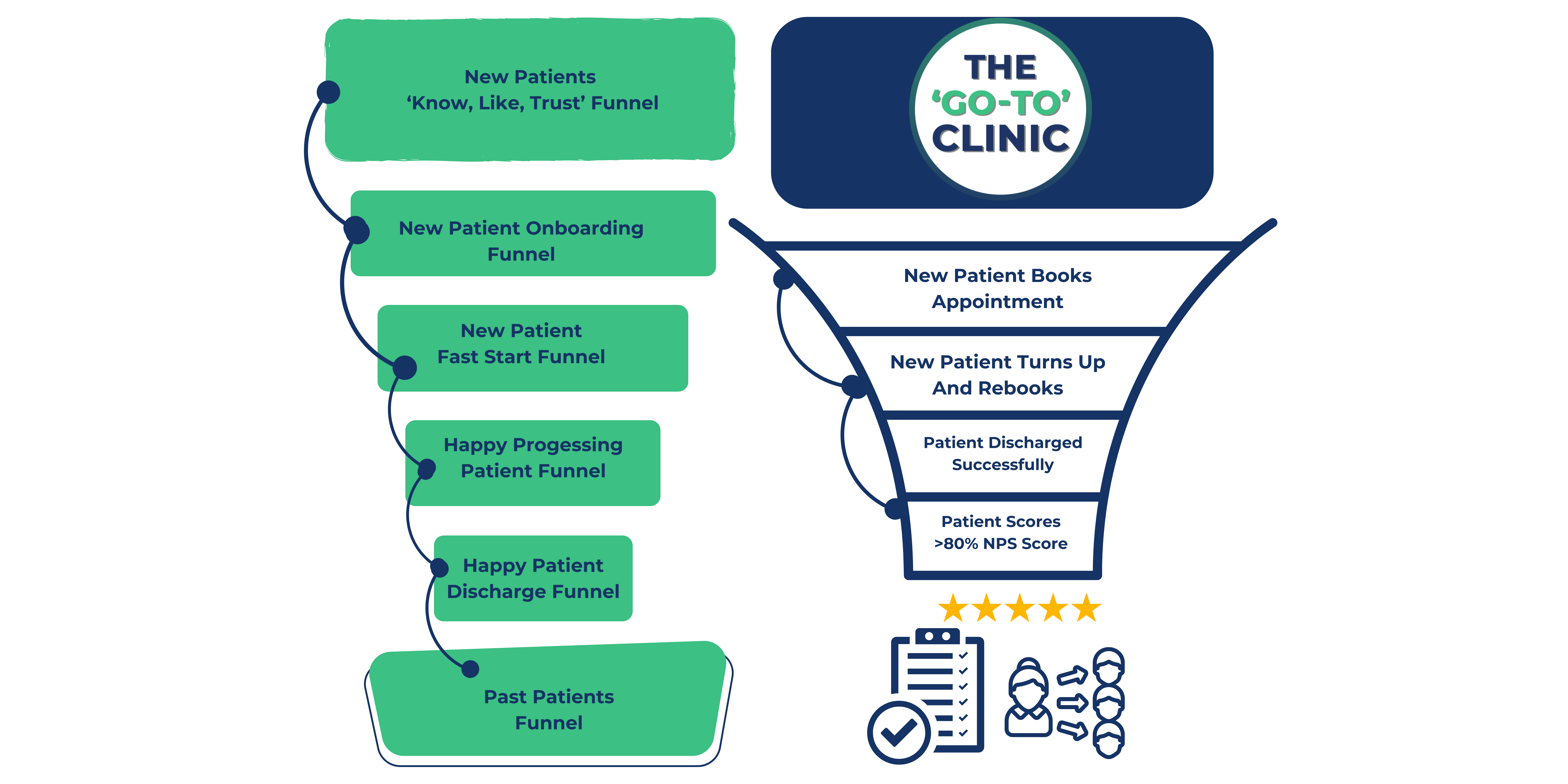
While the "Go-To Method" clinical frameworks facilitate exceptional rehabilitative outcomes, you need robust operational systems to amplify that impact into a thriving practice. That's why the mentorship also provides comprehensive business modelling aimed at one goal - cultivating passionate raving fans that actively refer.
The 'Go-To' New Patient Acquisition Engine
Generating a steady stream of pre-educated and invested new patients eager for your specific methodology and clinical expertise doesn't happen through random tactics. It requires purposeful, psychologically-informed systems nurturing prospects from initial curiosity through the "Know, Like, Trust” principle to book appointments.
Attracting the wrong type or ‘uneducated’ patient can rapidly erode operational efficiency, spiking cancellation rates, and plummeting team morale.
You'll receive the full strategic marketing blueprints, psychologically-optimised sales scripts, and conversion funnel architectures - uniting these components into one seamlessly automated engine. Properly indoctrinating patients positions your team for operational efficiency from day one and is the backbone behind a lean, profitable ‘Go-To’ clinic.
The 'Go-To' New Patient Onboarding Sequences
The ‘Go-To’ New Patient Onboarding sequence will do all the heavy lifting for you and your team to ensure your patients turn up to their initial assessment 80% ‘bought-in’. This eliminates the need for your therapists or admin team to do any awkward ‘selling’ in the first session. We equip you with patient communication workflows, onboarding materials, and expectation-aligning pre-work. This cements you as the respected clinical authority while inspiring commitment before treatment even begins.
The 'Go-To' Fast Start System
Now the patient has ‘bought-into’ your process, it is time to continue to build on this momentum to rapidly demonstrate progress and cement buy-in within the first week. You’ll have access to our bespoke patient exercise software in addition to all the standard operating procedures required to keep the patient progressing between sessions and ensure they return for their next session with a smile on their face.
The 'Go-To' Happy Progressing Patient Sequence
Now the patient has started fast, it is time to maintain progress even when the pain has eased. The ‘Happy Progressing Patients’ sequence will ensure no patient falls through the cracks and no lost opportunities for raving fans. The systems, tools and skills in this sequence will ensure your admin team are performing revenue generating activities and your therapists are super clear on tracking adherence, monitoring objective milestones and ensuring patients are on track towards raving fan status.
The 'Go-To' Happy Patient Discharge Process
Lacklustre offboarding can undermine even brilliant clinical results. We'll share specialised workflows that make capturing feedback, reviews and referrals seamless. You’ll also get differentiated follow-up sequences, and past patient promotion funnels. Patients won't just remain eternally grateful - they'll become your unstoppable referral engine fueling exponential growth.
The 'Go-To' Past Patient Reactivation Sequences
Once patients conclude their raving fan experience journey, the relationship needn't end there. We'll train you in maximising customer lifetime value through reactivation sequences, upstream earring, and portfolio promotion. You'll effortlessly capitalise on your clinical impact and always stay top of mind for further referrals and retention.
The 'Go-To' Operational System
Uniting these patient-centred processes under one cohesive systemised model is what facilitates consistent delivery of premium-level patient encounters. You receive the templates, frameworks, and implementation training to streamline the entire lifecycle into Google-like operational excellence. No more dropped balls, missed follow-ups, or fragmented touchpoints.
This complete "Go-To" system merges peerless clinical reasoning with world-class patient experience. You'll finally have the complete model to elevate yourself as the ‘Go-To’ specialist in your community - an authority facilitating life-changing results through both clincial mastery and patient-centred relationships.
Is it YOUR time to become a ‘Go-To’ Therapist In Your Town And Start Using The ‘Go-To’ Method?
If you're a physio, sports therapist or other healthcare professional and own or work in private practice...
This is the most POWERFUL process for effectively creating exceptional clinic results and a world class patient experience.
When you implement the ‘Go-To’ Method, it changes everything for you and your patients!
David Grey
David Grey had just returned from Australia and was seeing 3 patients a week and taking upwards of 2 hours per assessment before joining the mentorship program. David was looking for some structure and a way to put all his courses together to grow his practice.
As David Grey puts it, "It's not often you get support from one of the best physios in the world - having him at your back, someone you can talk to at any stage for guidance on treatment skills or business operations”. “The guys have an unbelievable system you can just follow," David raves.
After applying the system it dramatically simplified his assessments and cut down his appointment times. It also gave him a clear roadmap of always knowing where to go next with patients which gave him confidence to book patients back in for more sessions they ethically needed.
This in turn gave him the time required to get great results that earned reviews and referrals. His patient numbers quickly grew thereafter and the rest is history.
Chloe Wilson
Chloe Wilson was once trapped - rushed mornings treating patients, then off to her 9-5 job before late nights back at her UK clinic. "I constantly said yes with no control over sessions. I went through the motions with little clarity on next steps." Past courses only gave temporary boosts. Lockdown shattered her confidence. Then a friend mentioned The 'Go-To' Mentorship. Chloe joined our community and quickly realised hands-on skills were just tactics.
"The step-by-step system gave me a comprehensive strategy for working smarter while understanding the 'why' behind everything. Instead of chasing techniques, I addressed root causes keeping patients predictably progressing." Chloe mastered integrating subjective and objective findings into logical, visually-mapped treatment plans. She finally worked at her highest clinical reasoning level.
The results? Chloe ditched the 9-5 and nights/weekends while reigniting her passion. "My diary filled with raving fans and I doubled my patient volume!"
Greg Stern
"I wished I had learned this clinical reasoning system in physio school!" says Greg, a Canadian physiotherapist. Previously a "course junkie", Greg felt scattered - "throwing the kitchen sink" at patients without cohesive reasoning.
After joining the Mentorship, Greg finally understood how to integrate his random knowledge into a structured, evidence-based framework. "I grasped the rationale behind every step, giving me confidence to clearly explain my approach."
The 'Go-To' Physio system simplified complex, multi-joint mechanics and brought it together with modern pain science. Greg progressed patients through criterion-based, graded exposure milestones.
The impact? "I feel like I'm operating at a completely different clinical level now." Greg's consistency soared. His patient volume doubled from 10-15 per week as he confidently designed personal roadmaps for achieving life-changing results.
"For the first time, I genuinely believe I can solve even my toughest cases." Greg finally provided truly exceptional care.
Toni Stanton
"When someone walks in stiff with pain and can't move, then after the first session they're going 'Oh my God, I can move' - it's one of the most marvellous feelings giving someone that freedom," recounts Toni Stanton.
Before the 'Go-To' Mentorship, Toni saw around 10-15 patients weekly. Within one month of applying the structured system, she hit 20 patients per week. Now her waitlist stretches 5 weeks out.
"I was already hitting 20-30 patients within the first six months," Toni marvels. "You can really see how much this approach has impacted my practice." No more flailing through a random collection of techniques. The Mentorship provided Toni a comprehensive model for clinical reasoning and progressive rehabilitation - a structured step by step process for delivering consistently superior outcomes.
Ed Voss
A Chartered Physiotherapist says "Got a tricky patient? You can put up a case study, and within hours you've got responses - a really supportive, constantly evolving community."
This access to an expert knowledge base convinced Ed: "I feel I'll always have that to draw on until I finish being a physio. Taking action and enrolling was the best decision I've ever made for my career."
Before the Mentorship, Ed felt stagnant. "I was treating people fairly routinely - same old things for back pain, knee pain, etc. I needed a more logical yet individualised approach to get the best from my skills and for my patients." Now Ed raves, "It's completely changed how I work for the better. It's given me confidence, direction. My treatment is so much more logical, and my clients love it and keep coming back."
While the investment may seem daunting upfront, "You'll pay off that outlay over and over. The improvements you'll make as a therapist in the long-term are unbelievable."
Victoria Rendle
"Time management-wise, it's really helped," Victoria Rendle shares about the 'Go-To' Physio Mentorship. "My clinical reasoning is much clearer, so I complete notes and treatment planning within allotted times."
But the biggest impact? "It's enabled me to start preparing to step out of the business by reducing clinical time." How? "My team now speaks a similar language - we all use the same structured framework for progressing clients." Rather than individual therapists working in silos with scattered techniques, the Mentorship provided Victoria's practice with a unified clinical model and consistent patient experience.
"Having this common system lets me feel confident handing off cases," Victoria explains. "I can prepare to step away because I know we'll deliver exceptional care."
Who Is It For?
The ‘Go-To’ Method was designed for…
- Physiotherapists
- Physical Therapists
- Physical Therapy Assistants
- Osteopaths
- Chiropractors
- Sports Therapists
- Licensed Massage Therapists
- Strength Coaches
- Podiatrists
- Kinesiologists
- Pilates Teachers
- Yoga Teachers
- And Other Healthcare Professionals
And... The ‘Go-To’ Method works differently based on...IF you have your own clinic or just working in someone else’s private practice... or even you are thinking of making the jump into private practice…
And your experience level...
So, it doesn't matter if you are a student about to graduate and want to hit the ground running without making years of mistakes and trial and error or you’ve been in the profession for 30+ years…
We've implemented this method with success at all levels...(it just looks a little different)
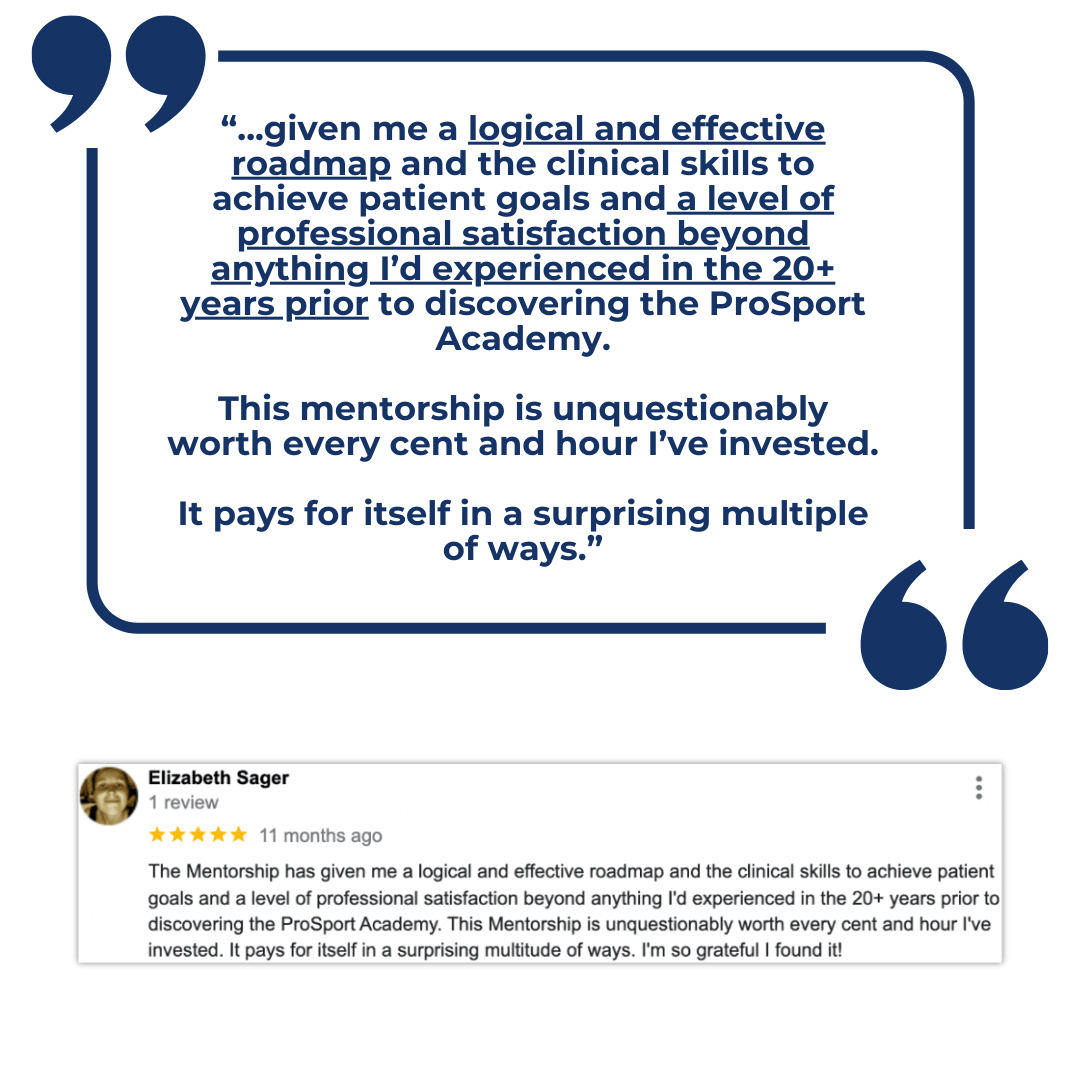
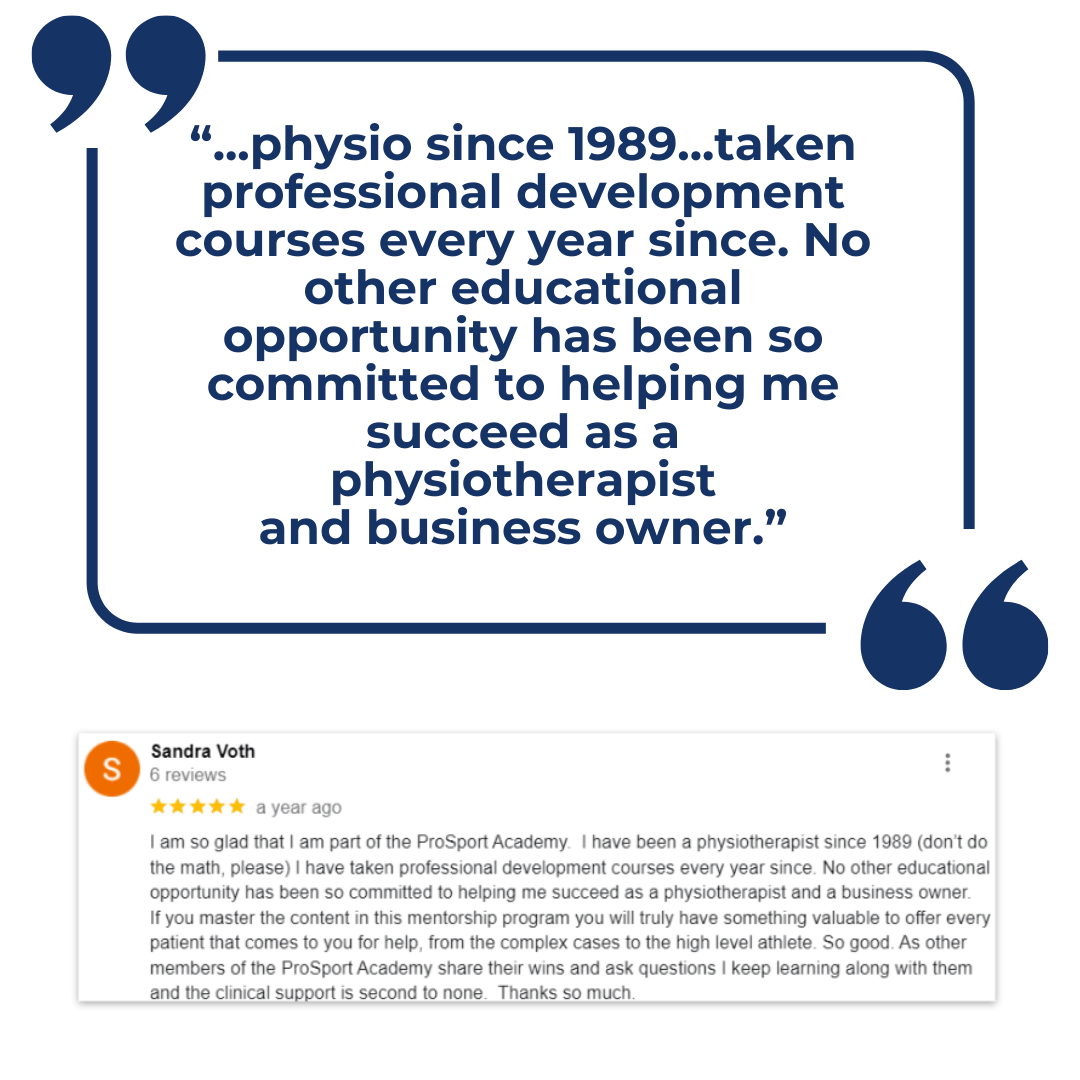
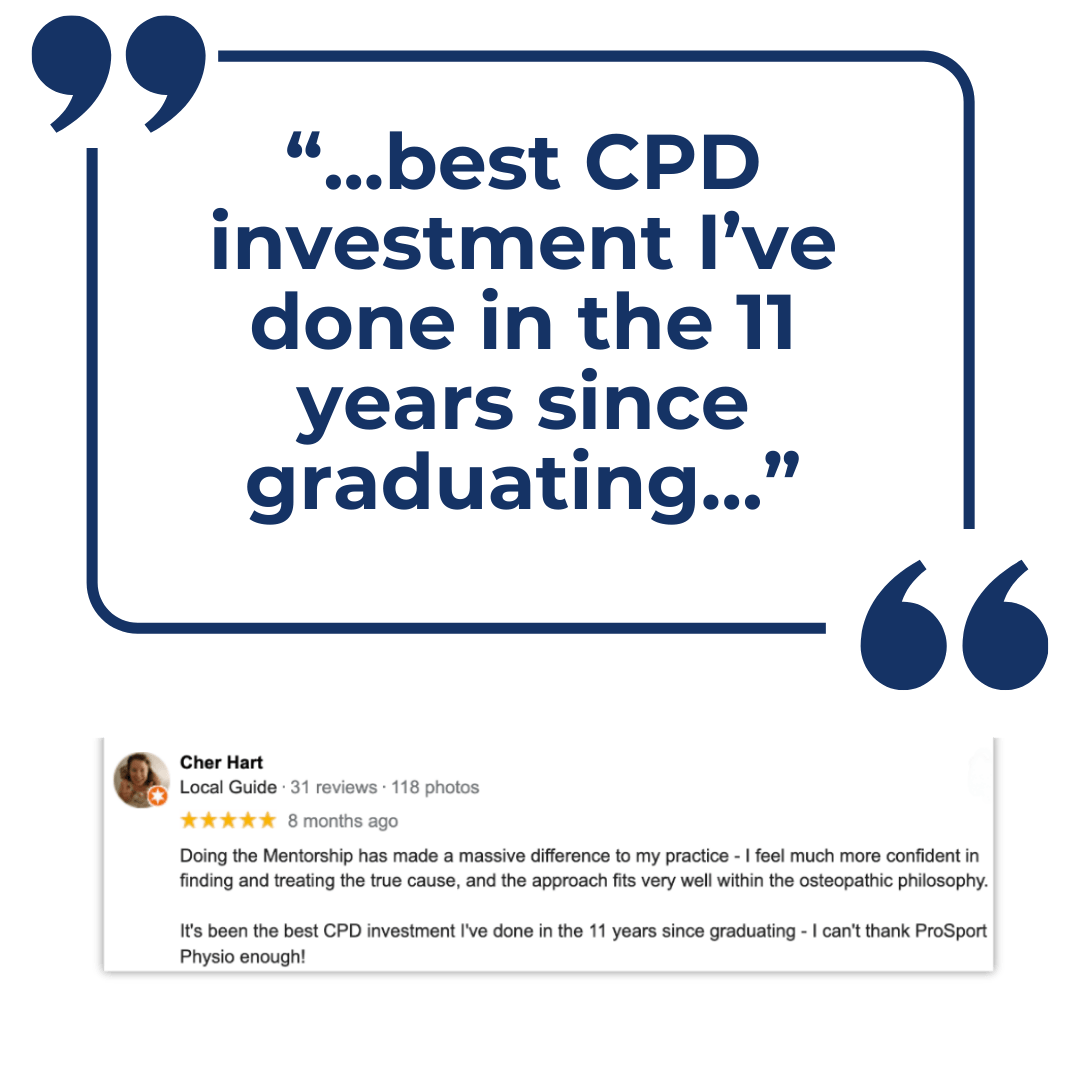
Who We Have Helped…
Oliver Waite
Crystal Palace FC
Mohamed Barakat
Wadi Degla FC
David Ferguson
Leeds Rhinos Head Physio
Nawal Gurung
Fulham F.C Sports Therapist
David Hanly
Connacht Rugby
Will Franklin
Leeds Utd Physiotherapist
David Grey
David Grey Rehab
Andy Chen
Moment Physical Therapy and Performance
Alex Morrell
Move Physiotherapy
Marty Loughran
Elite Physiotherapy, Northern Ireland
Laura Franklin
Laura Franklin Pilates And Physiotherapy, UK
Lisa Wiles
Hands That Heal, UK
Loretta Aliprandi
National Healthcare, Australia
Andy Ellis
National Healthcare, UK
Bridget Dean
National Healthcare, Australia
Larry Geraghty
Physical Therapy Course Leader
Declan Kearney
Physical Therapy Course Tutor
Dylan Seeley
Cash Based Chiropractor, USA
Nevin Saju
Cash Based PT, USA
Kim Aing
Cash Based PT Owner, USA
Carson Aune
Chiropractor, USA
Steven Tran
Chiropractor, Australia
Amy Bowzaylo
Sports Chiropractor, Bahrain
Mario Ciccone
Osteopath, UK
Eu Gene Chong
Osteopath
Cher Hart
Osteopath, UK
Miles Mitchell-Coop
Sports Therapist
Chloe Wilson
Sports Therapist
Stuart Bertram
Sports Therapist
Saoire Waldron
Podiatrist, Ireland
Adam Smith
Podiatrist, Scotland
David McKechnie
Podiatrist, UK
Rob Moloney
Molo Rehab & Performance
Andy Reay
Head Of S & C, Pure Sports Medicine
John Noonan
F2 Performance Coach
Okey Eze
Sports Massage Therapist
Katie Evans
Sports Massage Therapist
Kate Green
Sports Massage Therapist
Tricia Renshaw
Physical Therapist, USA
Jasper Chang
Athletic Therapist, USA
Edwin Santiagoa
Performance Coach, USA
Greg Stern
Ground Up Physiotherapy
Jill Saban
Physio Clinic Owner, Canada
Sandra Voth
Physiotherapist, Canada
Gina Nelson
Queensland Reds Physiotherapist
Aaron Turnbull
Physiotherapist, Brisbane
Dan Rehder
Brisbane, Australia
Milosz Milito
Osteopath, New Zealand
LeeVan Santos
Hurricanes Physiotherapist
Peter Hughes
All Black 7’s Rehab Physiotherapist
Tommy Brennan
Pain & Performance Clinic, Ireland
Fabio Torres
Portugal
Mira Rühl
Physiotherapist, Germany
Samantha Dunbar
South Africa
Michael Mann
South Africa
Tai Ellis
Cape Town
Jo Leung
Hong Kong
Zaki Hairodin
Singapore
Jonah Chung
Hong Kong
What's Next For You And Your Career?
Are you ready to explore implementing ‘Go-To’ Method into your practice?
Three Ways I Can Help…
Clinical Skills
Made Simple
Start your journey to patient care mastery with our foundational "Made Simple" short courses. Explore introductory programs starting at £97 to simplify your approach and transform your clinical clarity for happier, steadily progressing clients.
Learn MorePrivate Practice Therapist Mentorship & Training
For individual therapists, whether clinic owners or therapists working for someone else, to master clinical excellence with complex patients. Includes step-by-step systems, difficult case support, coaching, and access to proven treatment protocols. Everything you need to confidently solve challenging cases.
Learn MoreThe ‘Go-To’ Clinic
Business Mentorship
The complete package for clinic owners to deliver exceptional clinical results AND build a profitable, thriving clinic. You'll get comprehensive clinical mastery training plus proven marketing/operations systems to ethically grow while providing world-class patient experiences.
Learn More